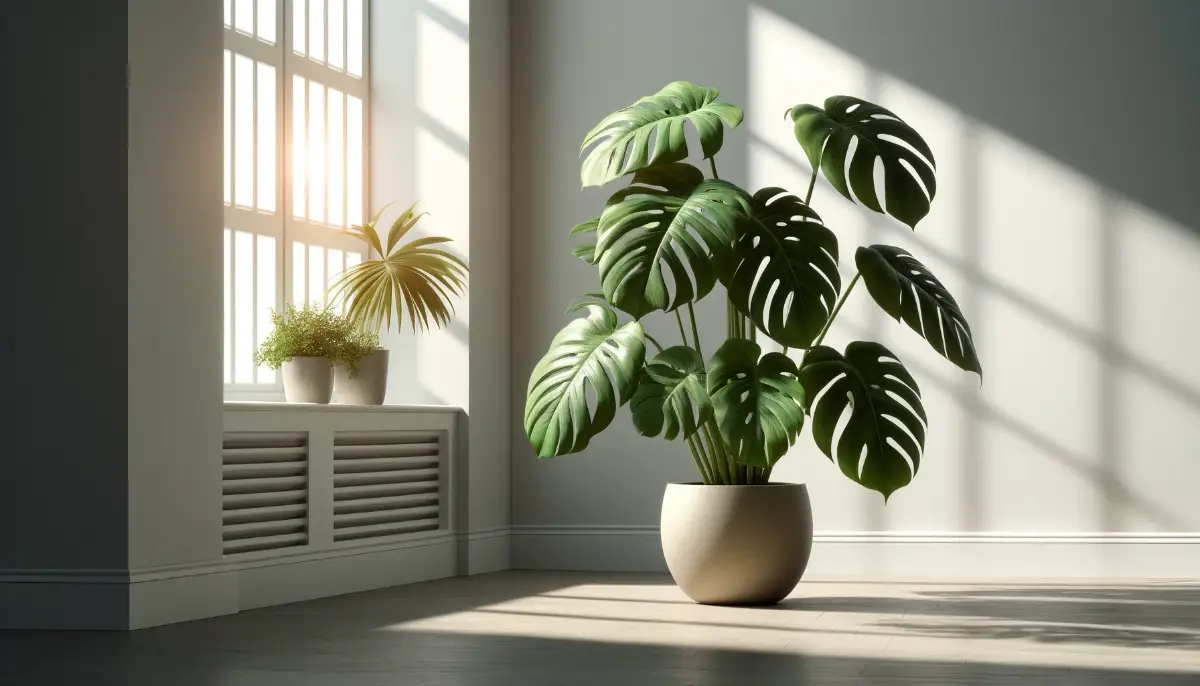Monstera deliciosa, commonly known as the Swiss Cheese Plant, is a stunning addition to any indoor garden with its lush foliage and unique, perforated leaves that evoke the holes in Swiss cheese. Beloved for its easy care and dramatic presence, this tropical plant not only beautifies homes but also purifies the air, making it a popular choice for both novice and experienced plant enthusiasts.
Thriving in bright, indirect light and requiring moderate watering, Monstera deliciosa adapts well to indoor conditions, growing large and verdant with the right care.
Toxicity
Monstera deliciosa is indeed toxic to pets and humans if ingested. The plant contains insoluble calcium oxalates, which are crystalline substances that can cause oral irritation, pain and swelling of the mouth, tongue, and lips, excessive drooling, vomiting, and difficulty swallowing if chewed or ingested.
These symptoms are a defense mechanism against herbivory, and they can be quite distressing to pets and small children who might be curious enough to chew on the leaves. It’s important to keep Monstera plants out of reach of pets and young children to prevent any accidental ingestion.
For homes with pets or small children, it’s advisable to consider non-toxic plant alternatives or ensure that your Monstera is placed in a location where it cannot be reached by curious paws and hands. If ingestion does occur, it is recommended to contact a veterinarian or medical professional promptly.
Optimal Growing Conditions
Light requirments
Monstera deliciosa thrives best in bright, indirect sunlight, which is crucial for promoting its lush, vibrant growth. While the plant can tolerate lower light conditions, it’s important to note that less light may lead to slower growth and fewer of the characteristic fenestrations, or holes, that Monstera leaves are known for.
In dimmer environments, the plant may also become “leggy” as it stretches towards the light source, potentially compromising its aesthetic appeal and overall health.
For optimal growth, placing your Monstera near a window that receives filtered light through sheer curtains, or a bit farther from a south- or west-facing window can provide the ideal lighting conditions. If natural light is limited, consider using grow lights to supplement the light needs of the plant.
Temperature requirements
Monstera deliciosa prefers warm, tropical climates and does best in indoor environments where temperatures range from 60° to 85° degrees Fahrenheit (15° to 29° Celsius). It is important to avoid placing your plant in locations where temperatures drop below 50° F (10° C) as cold drafts can damage the leaves.
During the winter months, if your home tends to be cooler, consider relocating your Monstera to a warmer spot or near a heat source to maintain optimal growth conditions. Maintaining a consistent temperature within the preferred range will help ensure your Monstera remains healthy and vibrant, promoting lush, green growth and the development of its distinctive leaf fenestrations.
Watering technique
Watering your Monstera deliciosa correctly is crucial for its health and growth. The plant benefits from a soak-and-dry method, which means allowing the top third of the soil to dry out before watering again. This technique helps prevent overwatering, which can lead to root rot and other issues.
When it’s time to water, do so thoroughly until water drains out of the pot’s bottom. This ensures the roots are adequately moistened and helps flush out any salt build-up from fertilizers. The frequency of watering will depend on several factors including the light, temperature, and humidity levels of your home as well as the season.
During the growing season, you may need to water more frequently, while in the winter, watering should be reduced as the plant’s growth slows down.
It’s also beneficial to check the moisture level of the soil regularly, either by touch or using a moisture meter, to gauge when it’s time to water. This proactive approach helps maintain the perfect moisture balance for your Monstera, ensuring it thrives in your home environment.
Soil and Repotting Essentials
Soil type
For Monstera deliciosa, the right soil mix is key to ensuring healthy growth and preventing issues such as root rot. A well-draining, peat-based potting mix is ideal for this plant. The peat helps to retain moisture, yet the mix should also contain other components like perlite or sand to improve drainage.
When preparing the soil for your Monstera, consider adding some organic matter, such as compost or coco coir, which can enhance the soil’s nutrient content and further improve moisture retention. Ensuring the pot has adequate drainage holes is equally important to allow excess water to escape, preventing the roots from sitting in too much moisture.
Helpful Article: How to Make Your Own Organic Soil
Regularly check the soil condition and refresh it as needed to maintain its quality and support the health of your plant. This might involve replacing the soil every couple of years during repotting or simply topping up with fresh soil to replenish nutrients.
Repotting
Repotting Monstera deliciosa is an essential part of its care, ensuring the plant continues to grow and thrive. Typically, Monsteras should be repotted every two years to accommodate their rapid growth and prevent them from becoming root-bound. Here’s a step-by-step guide on how to effectively repot a Monstera:
- Choose the Right Time: The best time to repot is during the spring or early summer when the plant is in its active growing phase. This timing helps the plant to quickly recover and resume growth.
- Selecting a New Pot: Choose a pot that is 2 inches wider than the current one. This provides enough space for the roots to expand without giving so much space that the soil stays damp and risks root rot. Ensure the new pot has adequate drainage holes.
- Prepare the Soil: Use a well-draining, peat-based potting mix. You can enhance this by adding perlite or bark to improve aeration and drainage, which is critical for Monstera’s health.
- Remove the Plant: Gently take the plant out of its current pot. Shake off loose soil from the roots and inspect them. Trim any rotten or excessively long roots to promote healthier growth.
- Repotting: Place some soil in the bottom of the new pot. Set the plant in and fill around the roots with fresh potting soil, pressing down lightly to eliminate air pockets. Ensure the plant is at the same depth it was in the old pot to prevent stem rot.
- Water Thoroughly: After repotting, water the plant thoroughly to help settle the soil and eliminate air gaps around the roots. This also helps the roots make contact with the new soil, aiding in recovery and growth.
- Post-Repot Care: Place the repotted Monstera in a location where it gets adequate indirect light. Avoid fertilizing for about a month to allow the roots to heal and adjust to the new environment without being burned by fertilizer salts.
Repotting not only refreshes the nutrient environment for your Monstera but also gives it the necessary space to continue its growth, making it a crucial aspect of caring for your Swiss Cheese Plant.
Organic Fertilization Schedule
For Monstera deliciosa, using organic fertilization can help ensure healthier growth and development while being environmentally friendly. Here’s an optimal schedule for fertilizing your Swiss Cheese Plant with organic nutrients:
- Frequency of Fertilization: Fertilize your Monstera once a month during the growing season, which is typically from spring to early autumn. During the dormant period in fall and winter, reduce or eliminate fertilization to prevent overfeeding, which can harm the plant as its growth slows down.
- Type of Organic Fertilizer: Use a balanced, water-soluble organic fertilizer with an NPK ratio that supports leaf growth and overall health. Look for formulations that are specifically designed for houseplants or tropical plants. Products that include natural ingredients like seaweed, fish emulsion, or compost extracts are great choices for providing essential nutrients without the harsh chemicals found in some synthetic fertilizers.
- Application Method: Mix the organic fertilizer according to the package instructions and apply it to the soil, not directly on the plant leaves or stem. Water your Monstera before and after applying fertilizer to prevent root burn and ensure even distribution of nutrients throughout the soil.
- Monitoring Plant Response: After fertilizing, observe your plant for signs of response. Good signs include new growth and richer, greener leaves. If you notice any negative reactions, such as leaf burn or wilting, it might indicate over-fertilization, and you should adjust the frequency or concentration of the fertilizer accordingly.
- Soil Health: Periodically, it’s beneficial to flush the soil with water to remove any buildup of salts from the fertilizers, which can accumulate and potentially harm the plant roots. Simply pour water through the soil until it runs clear from the drainage holes, and then allow the pot to drain completely.
By following this organic fertilization schedule, you’ll provide your Monstera deliciosa with the nutrients it needs to thrive while maintaining an eco-friendly care routine.
Pruning and Maintenance
Pruning and maintaining your Monstera deliciosa not only helps keep it looking its best but also supports healthy growth and vitality. Here’s a guide on how to effectively prune and maintain your Swiss Cheese Plant:
Why Prune: Regular pruning helps control the size of your Monstera, encourages a fuller appearance, and removes unhealthy parts of the plant that could be draining its resources. It also allows for better air circulation around the plant.
When to Prune: The best time to prune Monstera is during the spring or early summer, as this is when the plant is in its active growth phase and can recover more effectively from any stress caused by pruning.
How to Prune:
- Remove Yellow or Brown Leaves: These are usually a sign of age or stress. Gently snip these leaves at the base near the main stem using clean, sharp scissors or pruning shears.
- Trim Back Overgrowth: If your Monstera is getting too large or leggy, you can trim back the stems to a manageable size. Make cuts just above a leaf node (where leaves emerge from the stem), which will also encourage branching.
- Shape the Plant: For aesthetic purposes, you may want to shape your Monstera by selectively pruning to create a more balanced look.
Care After Pruning:
- After pruning, ensure to clean any wounds on the plant with a mild antiseptic to prevent infection.
- Adjust your watering and care routine if necessary, as the plant may need less water given its reduced size after pruning.
Ongoing Maintenance:
- Regularly check for pests such as spider mites, thrips, or mealybugs. These can often be managed by wiping the leaves with a damp cloth or using an appropriate organic insecticide.
- Dust the leaves occasionally to ensure they can photosynthesize efficiently. This can be done with a soft, damp cloth.
Support Structures: Since Monstera deliciosa is a climbing plant, providing support such as a moss pole or trellis can help it grow upright and remain healthy. Attach the stems to the support with soft ties to encourage vertical growth.
By following these pruning and maintenance tips, your Monstera deliciosa will continue to thrive and bring tropical beauty to your home or office.
Propagation Techniques
Propagating Monstera deliciosa can be a rewarding way to expand your collection or share this striking plant with friends and family. There are two main techniques commonly used for propagation: stem cuttings and air layering. Here’s a detailed guide on each method:
Stem Cuttings:
- Preparation: Choose a healthy stem with at least one leaf and a node (an area where leaves are attached to the stem). Cuttings should be taken with clean, sharp shears to avoid damaging the plant.
- Rooting Medium: You can root Monstera cuttings either in water or directly in soil. For water rooting, place the cut stem in a jar filled with water, ensuring that the node is submerged. Change the water every few days to keep it fresh. For soil rooting, plant the cutting in a pot filled with a well-draining, peat-based potting mix.
- Care During Rooting: Keep the cutting in a warm place with bright, indirect light. Roots typically begin to form within a few weeks. Once the roots are a few inches long, the cutting can be transplanted into a permanent pot.
Air Layering:
- Preparation: This method is useful for larger, established plants. Identify a section of stem that has an aerial root or node. Make a small incision below this point, which helps stimulate root growth.
- Wrapping: Wrap the area with damp sphagnum moss, then cover it with plastic wrap to maintain moisture. Secure the plastic with ties but ensure some air can still circulate.
- Root Development: Over the course of several weeks to months, roots will develop within the moss. Once a substantial root system has formed, the new section can be cut from the main plant and potted separately.
Both propagation techniques require patience and proper care to ensure success. It’s important to maintain a stable environment with adequate humidity and temperature to support root development. After the new plant is established, it can be treated as a typical Monstera deliciosa, following standard care guidelines.
By utilizing these propagation methods, you can effectively multiply your Monstera collection and enjoy the lush, tropical vibe they add to any indoor setting.
Troubleshooting Common Issues
Monstera deliciosa is generally robust but may face a few common issues related to watering, lighting, or pests. Here’s a guide to troubleshooting some typical problems you might encounter:
Yellowing Leaves:
- Cause: Often a sign of overwatering, but can also be due to under-watering.
- Solution: Check the moisture level of the soil to determine if it’s too wet or too dry. Adjust your watering schedule accordingly, ensuring that the top third of the soil dries out before watering again.
Browning Leaf Tips:
- Cause: Usually due to dry air or under-watering.
- Solution: Increase humidity around the plant using a humidifier or pebble tray. Make sure the plant is receiving consistent, thorough watering without letting the soil become soggy.
Pest Infestations (e.g., spider mites, mealybugs):
- Cause: Often occurs in dry conditions.
- Solution: Increase humidity and regularly clean leaves with a damp cloth. If pests are visible, treat the plant with insecticidal soap or neem oil, applying as directed on the product label.
Helpful Articles:
Step-by-Step Homemade Insecticidal Soap
How to Control Pests and Diseases in an Organic Indoor Garden
Top 10 Plants to Naturally Repel Insects
Stunted Growth or Lack of Fenestrations:
- Cause: Insufficient light is a common reason for slow growth and lack of leaf development.
- Solution: Move your Monstera to a brighter location with indirect sunlight. If that’s not possible, consider using grow lights to supplement the light.
Root Rot:
- Cause: Overwatering leading to soggy soil conditions.
- Solution: Ensure the pot has good drainage and the soil does not hold excess water. If root rot is suspected, remove the plant from its pot, trim away any black or mushy roots, and repot in fresh, well-draining soil.
Addressing these issues promptly can help prevent further damage and keep your Monstera deliciosa healthy and thriving. Regular monitoring and adjusting care routines as needed are key to managing these common problems.
FAQs about Caring for Monstera deliciosa (Swiss Cheese Plant):
How often should I water my Monstera deliciosa?
Water when the top third of the soil feels dry. Typically, this will be about once a week, but it can vary based on the environment.
What is the best light for Monstera deliciosa?
Monstera deliciosa thrives in bright, indirect sunlight. Direct sunlight can burn the leaves, while too little light can stunt growth and reduce fenestration (leaf holes).
How do I know if I am overwatering my Monstera?
Signs of overwatering include yellowing leaves, a musty smell, and a soggy potting mix. If the leaves also have crispy brown spots, it might be due to root rot.
Can Monstera deliciosa grow in low light?
Yes, it can tolerate low light, but it will grow slower and produce fewer fenestrations. Supplemental lighting can help if natural light is insufficient.
When should I repot my Monstera deliciosa?
Repot every two years or when the plant outgrows its pot, usually signaled by roots emerging from the drainage holes. Spring or early summer is the best time for repotting.
What type of potting mix is best for Monstera deliciosa?
Use a well-draining, peat-based potting mix with elements like perlite or bark to improve drainage and prevent waterlogging.
What are the common pests that affect Monstera deliciosa and how can I treat them?
Common pests include spider mites, mealybugs, and scale insects. Treat infestations with insecticidal soap or neem oil, and increase humidity to deter pests.
Why are my Monstera’s leaves turning brown at the tips?
Brown tips can be caused by low humidity, over-fertilizing, or under-watering. Adjust your watering schedule and ensure the plant is in a humid environment.
How can I encourage my Monstera to have more fenestrations?
Provide adequate bright, indirect light as the plant matures. Younger plants typically have fewer fenestrations, which increase as the plant ages and is exposed to optimal lighting conditions.
Is Monstera deliciosa toxic to pets?
Yes, Monstera deliciosa is toxic to cats and dogs if ingested. The plant contains calcium oxalate crystals that can cause oral irritation and digestive upset









